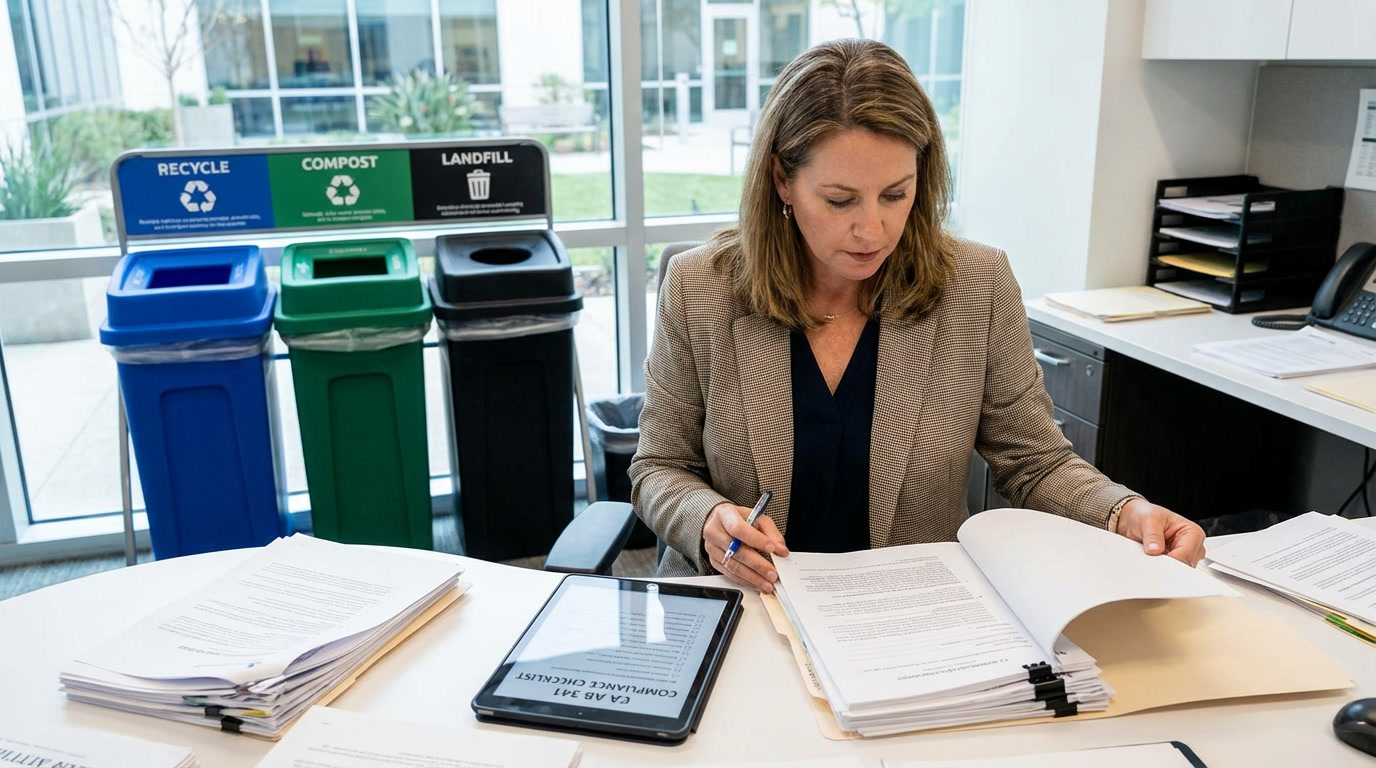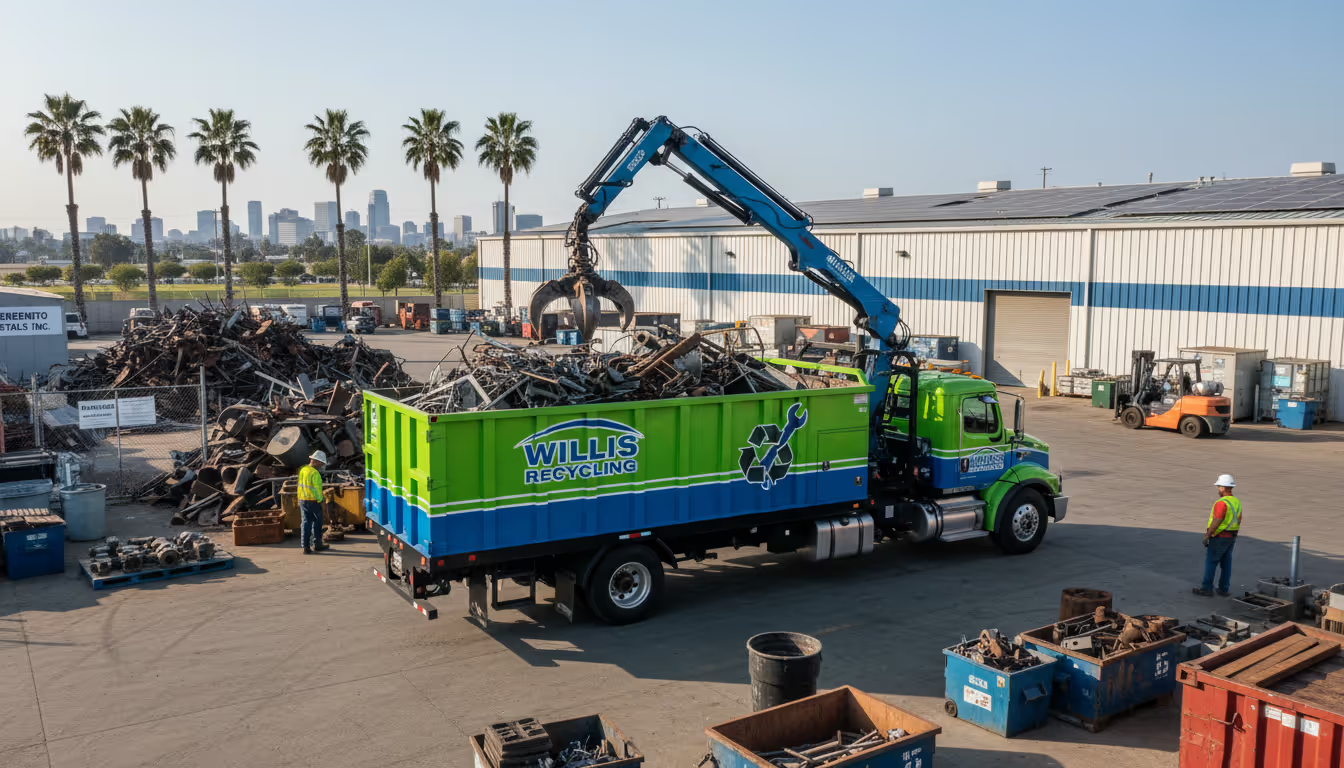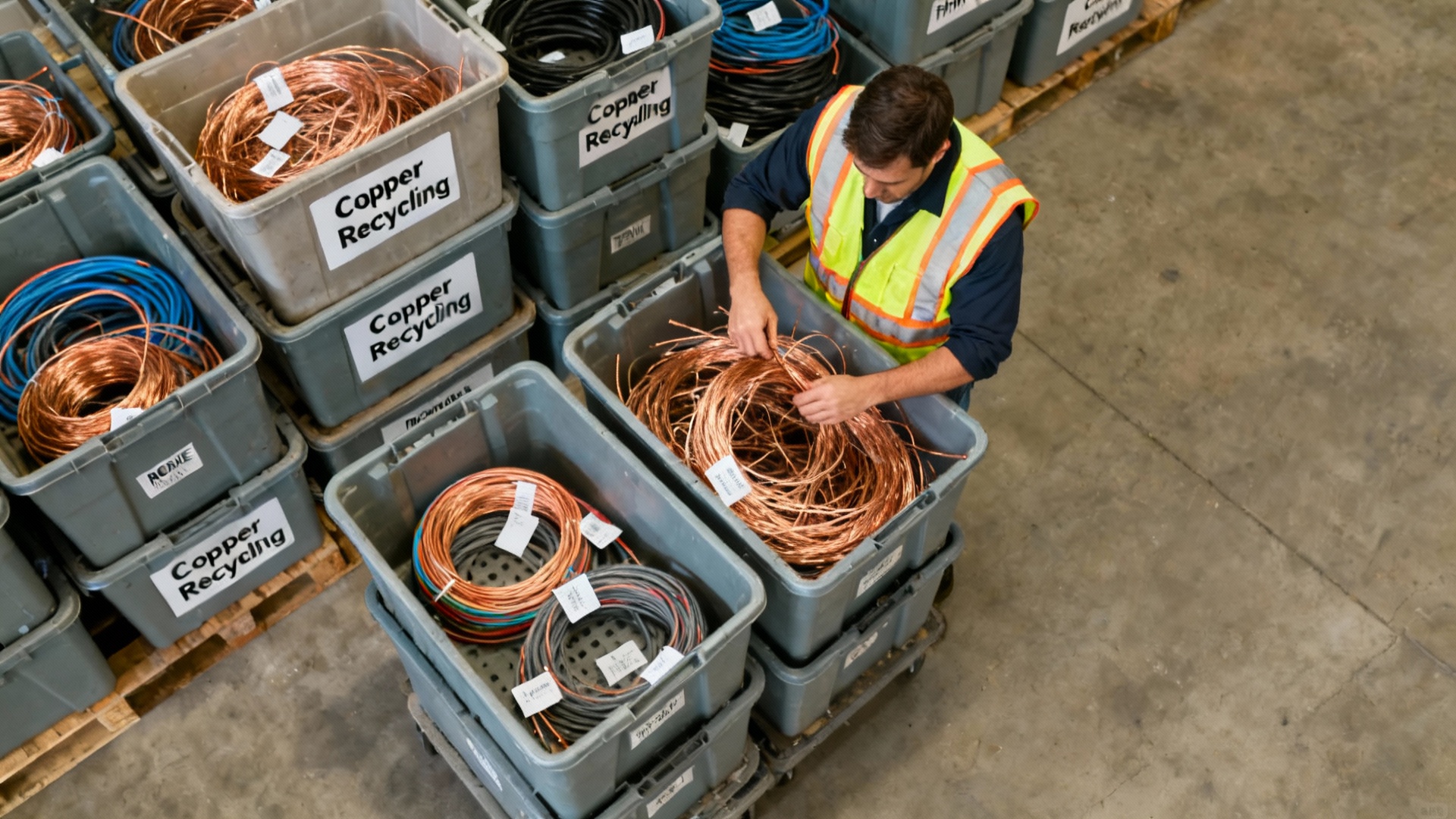Since 2012, California has required most businesses to recycle. That's Assembly Bill 341 in a nutshell, and it forms the foundation of AB 341 compliance California regulations. But if you're running operations in Sacramento or anywhere across the Central Valley, you've probably noticed that staying compliant isn't quite as simple as ordering an extra bin.
The regulations have layered on top of each other—first AB 341, then AB 1826 for organics, and most recently SB 1383 with its stricter enforcement. What started as a straightforward "please recycle" law now comes with documentation requirements, potential penalties, and enough acronyms to make your head spin.
Here’s what you actually need to know to stay on the right side of AB 341 compliance California mandates and the broader set of state recycling requirements.
Who the Law Applies To (And Who Gets a Pass)
AB 341 targets two main groups. First, any business or public entity generating four or more cubic yards of solid waste per week needs a recycling program. This is the core threshold used in determining AB 341 compliance California applicability. That’s total waste—your trash, recyclables, and organics combined, not just what ends up in the dumpster.
Second, apartment complexes and condos with five or more units fall under these rules. If you're managing multi-family housing, you're included.
Four cubic yards is less than you might think. Picture a commercial dumpster about four feet in each direction. Most retail operations, restaurants with decent foot traffic, office buildings, and certainly industrial facilities hit this threshold without trying. A busy construction site? You're definitely over the line.
Exemptions exist but they're narrow. Physical space constraints might qualify you if there's genuinely nowhere to put additional bins, even with creative container placement. Some rural areas with limited recycling infrastructure can request waivers. But you can't just decide you're exempt—it requires formal approval from your local jurisdiction, usually with a site visit and documentation proving the hardship.
What Changed When SB 1383 Showed Up

This trips up a lot of operations managers who thought they had AB 341 compliance California under control. AB 341 established the basic recycling requirement back in 2012. Then January 2022 arrived with SB 1383, which didn't replace AB 341 but added new layers on top of it.
The practical difference? You now need three separate waste streams instead of two. Recyclables go in blue bins, organic waste including food scraps goes in green bins, and actual trash goes in gray or black bins. Before SB 1383, many businesses could get by with just recycling and trash.
There's also real enforcement now. AB 341 relied mostly on education—jurisdictions would notify you if you weren't compliant and help you get set up. SB 1383 brought monetary penalties. They're not looking to bankrupt anyone, but fines do happen for persistent non-compliance.
California set ambitious targets with these laws. The state aimed for 75% waste diversion by 2020. Reality fell short—the actual rate only reached about 42% [1]. That gap between goal and outcome is why enforcement has gotten more serious. Regulators realized voluntary compliance wasn't cutting it.
The Materials You're Required to Separate
To meet AB 341 and SB 1383 requirements, businesses need to properly separate materials in ways that satisfy AB 341 compliance California standards.
Paper and cardboard are the easy ones. Office paper, junk mail, newspapers, magazines, and all those shipping boxes from your suppliers need to be recycled. If you're in retail or distribution, cardboard is probably your highest-volume recyclable. Flatten boxes before tossing them to maximize bin capacity.
Metals include more than just soda cans. Steel and tin cans from your break room count. For businesses in construction, manufacturing, or facilities management, you're also looking at scrap metals—copper wire, aluminum extrusions, steel beams, brass fixtures. These materials often have commodity value, which we'll get to later.
Plastics are trickier. Bottles and containers marked #1 through #5 typically work in standard recycling programs. That covers water bottles, milk jugs, detergent containers, and most rigid plastic packaging. But plastic bags, film wrap, and anything marked #6 or #7 usually can't go in your recycling bin. They gum up sorting equipment at recycling facilities.
Glass means bottles and jars from food service operations. Not window glass, not light bulbs, not ceramic dishes—just beverage and food containers.
Organic waste entered the picture with SB 1383. Food scraps, coffee grounds, napkins, paper towels, food-soiled pizza boxes, yard trimmings, and untreated wood waste now require separate collection. This is the stream that catches businesses off guard because it wasn't part of the original AB 341 requirements.
Three Ways to Comply (Pick What Works)
California gives businesses flexibility in achieving both SB 1383 and AB 341 compliance California:
Option 1: Contract with a waste hauler. This is the straightforward path. Sign up for service that provides separate bins for trash, recycling, and organics. The hauler picks everything up on schedule, sorts what needs sorting, and sends materials to appropriate facilities. You handle proper sorting on your end, they handle everything downstream.
Option 2: Self-haul your materials. If you've got the logistics capacity and it makes economic sense, you can transport recyclables directly to processing facilities yourself. Construction contractors sometimes prefer this route for scrap metal because they can negotiate pricing directly with recyclers. The catch: you must keep detailed records. Every trip needs documentation—receipts, weight tickets, dates, facility names, material types. It's more paperwork than hiring a hauler.
Option 3: Mixed waste processing. Some waste companies offer single-stream service where everything goes in one bin and they sort it at a processing facility. This works if the facility achieves diversion rates comparable to source separation—typically 50% or higher. You need documentation from your hauler proving their facility's performance meets regulatory standards. Not all jurisdictions accept this option.
Documentation That Actually Matters

California's AB 341 requires more than just having bins. You need proof you're recycling, and local jurisdictions do check.
Keep your waste service contract or agreement showing you've arranged for recycling collection. If you self-haul, maintain a log with dates, materials, quantities, and facility receipts. Monthly invoices from your waste service work well for demonstrating ongoing compliance.
Training records help too. If an inspector asks how employees know what goes in which bin, "we told them" sounds weaker than "here's the sign-in sheet from our September training session."
Store everything for at least three years. That's not an official requirement in the statute, but it's smart practice. Jurisdictions can audit your compliance history, and having organized records from the past few years shows you've been taking this seriously.
The biggest documentation mistake? Assuming good intentions count as compliance. "We recycle" without paperwork means you're technically non-compliant during an inspection. Paper trail matters.
Cost Reality Check
Let's talk money, because that's what most operations managers care about. Does recycling cost extra? Sometimes yes, sometimes no.
Many waste haulers bundle recycling collection with trash service at minimal additional cost. You might pay slightly more monthly, but the increase often gets offset when you downsize your trash container because you're diverting materials. Less trash means you can go from a six-yard dumpster to a four-yard, reducing your overall bill.
For certain materials, there's revenue potential. Cardboard bales have commodity value. Scrap metals definitely do. While AB 341 doesn't require haulers to pay you for recyclables, businesses generating significant volumes can sometimes arrange revenue-sharing agreements or at minimum get free pickup for materials with market value.
But here's the honest part nobody wants to admit: recycling compliance doesn't always save money. Some businesses do see lower costs. Others pay more. It depends on your waste composition, container configuration, hauler pricing, and local market conditions. The law doesn't care whether it saves you money—compliance is mandatory regardless.
The cost argument that actually holds up? Avoiding penalties. SB 1383 fines vary by jurisdiction but they're real. Staying compliant costs less than paying penalties and then having to comply anyway.
Regardless: complying with AB 341 compliance California avoids penalties and keeps your operation legally protected.
Implementation Without the Headaches
Getting your operation compliant doesn't require a project manager and six months of planning. Here's a streamlined approach:
Start with assessment. Look at what you're currently throwing away. Is it mostly cardboard? Food waste? Mixed materials? Understanding your waste composition helps you right-size containers and choose services that actually fit your situation.
Set up infrastructure. Place clearly labeled bins where employees and customers naturally generate waste. If people have to walk past three doors to reach the recycling bin, contamination rates will be terrible. Make it convenient.
Train your team. Five minutes in a staff meeting showing what goes where prevents months of contamination headaches. Include pictures, not just lists. "Plastic bottles" is vague. A photo of a water bottle with a checkmark and a photo of a plastic bag with an X is clearer.
Document everything from day one. File your service agreement. Save your invoices. Take a photo of your bin setup. Future-you doing an inspection will appreciate past-you being organized.
Check bins periodically. Quick visual inspections catch problems early. If your recycling bin is half full of food waste or your organics bin has plastic bags in it, more training is needed.
These steps align closely with successful AB 341 compliance California programs.
Industry-Specific Realities
Construction and demolition operations generate huge volumes of recyclable materials—scrap metals, wood waste, cardboard from deliveries. Segregating on-site isn't just good for compliance; it's good for recovery value. A pile of mixed construction debris has little value. Separated metal, wood, and cardboard can actually generate revenue. Many Sacramento contractors work with mobile recycling services that place bins directly at job sites and handle material recovery.
Retail and grocery businesses deal primarily with cardboard and plastics. If you've got food service, organics enter the picture. Baling cardboard before pickup reduces collection frequency and sometimes gets you better pricing from haulers. A basic cardboard baler pays for itself within a year or two for most retailers.
Healthcare facilities have unique challenges with regulated medical waste, but standard office areas, cafeterias, and maintenance operations all generate normal recyclables covered by AB 341. Proper segregation means you're not paying medical waste disposal rates for cardboard boxes and aluminum cans.
Warehouses and distribution centers move massive amounts of packaging materials. Cardboard, stretch wrap, pallets, and protective packaging all add up fast. Setting up source separation at receiving docks—right where materials enter the building—prevents recyclables from mixing with trash downstream.
Common Compliance Mistakes
Contamination tops the list. Food waste in recycling bins. Plastic bags in organics. Regular trash in both. Contaminated loads often can't be processed, defeating the entire purpose. Clear labeling with pictures helps, but ongoing vigilance matters more.
Inadequate documentation runs second. Just having bins without service agreements or invoices leaves you exposed during inspections. The inspector doesn't know whether you're actually recycling or just collecting materials that end up in the landfill anyway.
Ignoring SB 1383's organics requirements catches businesses that got AB 341 figured out years ago. "We've had recycling since 2013" doesn't mean you're compliant in 2025 if you're missing the organics piece.
Assuming exemptions apply without verification causes problems. Space constraints might seem obvious to you, but without formal waiver approval from your jurisdiction, you're still required to comply. Don't assume—confirm.
All of these can jeopardize AB 341 compliance California status.
What Local Inspections Actually Look Like

Most jurisdictions take an educational approach first. An inspector visits, checks whether you've got properly labeled bins for all three streams, asks to see your service agreement or self-haul documentation, maybe walks through your facility looking for obvious problems.
If they find issues—say you're missing organics collection or have no documentation—you typically get a notice explaining what needs to be fixed and a reasonable timeline to comply. It's not an ambush situation designed to catch you and issue fines. They genuinely want businesses compliant.
Second and third violations get more serious. That's when penalties enter the picture. But persistent non-compliance usually means you're ignoring multiple notifications, not that you made an honest mistake.
What helps during inspections: organized documentation in one place, clearly labeled bins actually in use, staff who can explain your recycling procedures. What hurts: playing dumb, claiming ignorance of requirements, having zero documentation, or bins that are obviously just for show.
Resources Actually Worth Using
CalRecycle’s website (calrecycle.ca.gov) commercial recycling guides, local waste coordinators, hauler assessments, and industry association guides are all extremely helpful for maintaining AB 341 compliance California.
Your local waste coordinator—every California city and county has one—is genuinely helpful. They can explain local requirements, connect you with haulers, and answer compliance questions. These are free resources funded specifically to help businesses comply.
Many waste haulers offer free assessments where they analyze your waste stream and recommend optimal service configurations. This helps them sell you service, yes, but the information is still useful for understanding exactly what you're discarding.
Industry associations relevant to your sector often have California-specific compliance guides. Construction, retail, healthcare, and manufacturing all have trade groups that have done the homework on recycling requirements.
Mobile Recycling Services for Central Valley Businesses
For operations in Sacramento and throughout Northern California's Central Valley, on-site recycling pickup simplifies compliance significantly. Mobile services bring capacity directly to your facility rather than requiring you to haul materials elsewhere.
This is particularly valuable for businesses dealing with bulk recyclables—cardboard bales, scrap metals from construction, steel racking from warehouse reconfigurations, or aluminum from manufacturing operations. Scheduled pickups with proper documentation satisfy compliance requirements without additional logistics management on your end.
Willis Recycling provides mobile recycling services throughout the Sacramento region and Central Valley. Whether you're dealing with commercial scrap metal, cardboard, or other recyclable materials, scheduled service includes the documentation local jurisdictions require during compliance audits—service agreements, weight tickets, and pickup records.
If you're unsure about your current compliance status or need help establishing a program that meets AB 341 and SB 1383 requirements, an on-site assessment can clarify exactly what your operation needs. Contact Willis Recycling to discuss compliance-ready recycling services for your Sacramento or Central Valley facility.
Looking Ahead
California's environmental regulations keep evolving. AB 341 set the foundation. SB 1383 raised expectations. Future updates will likely bring additional requirements. Staying informed through CalRecycle updates and local jurisdiction communications helps you stay ahead of changes rather than scrambling to catch up.
The regulatory trend is clear—California is serious about waste reduction and circular economy principles. Businesses that build robust recycling and organics programs now are positioning themselves for whatever comes next. Plus, many operations discover that systematic waste management reduces costs and improves operational efficiency beyond just compliance.
The goal isn't perfection. It's establishing functioning systems, maintaining documentation, and making good-faith efforts to comply with regulations that ultimately aim to reduce the environmental impact of business operations across California.
Frequently Asked Questions
Q: How do I know if my business generates four cubic yards of waste per week?
A: Four cubic yards is roughly equivalent to a commercial dumpster measuring four feet deep, four feet wide, and four feet tall. To determine your waste generation, review your waste service bills—most haulers list container size and pickup frequency. If you have a six-yard dumpster emptied twice weekly, you're generating twelve cubic yards total. Remember, the four-yard threshold includes all solid waste: trash, recyclables, and organics combined. Your waste hauler can provide exact volume data from your service records if you're uncertain.
Q: What's the relationship between AB 341 and SB 1383?
A: AB 341, enacted in 2012, established mandatory commercial recycling for businesses generating four cubic yards of waste weekly. SB 1383, effective January 2022, expanded these requirements by adding mandatory organic waste collection, setting a 75% waste diversion target by 2025, and introducing enforcement mechanisms with potential monetary penalties. AB 341 laid the groundwork for recycling; SB 1383 added organics requirements and real enforcement teeth. Both remain in effect—you need to comply with both sets of requirements.
Q: Can my business get an exemption from AB 341 requirements?
A: Limited exemptions exist but require formal jurisdiction approval. Physical space constraints may qualify if you can demonstrate that adding recycling containers is genuinely impossible even with container resizing or strategic relocation. Some rural businesses in areas lacking adequate recycling infrastructure can request waivers. However, you cannot self-declare an exemption. You must submit a formal waiver application to your local waste authority with supporting documentation and expect a site visit. Without approved exemption paperwork, compliance remains mandatory regardless of perceived barriers.
Q: What documentation do I need to maintain for compliance?
A: Essential documentation includes your waste service contract or agreement showing you've arranged for recycling and organics collection, monthly invoices from your waste hauler proving ongoing service, weight tickets and receipts if you self-haul materials to recycling facilities, and employee training records demonstrating staff understand proper sorting procedures. Maintain these records for at least three years. During inspections, organized documentation proving you've established and maintained a recycling program is just as important as having the physical bins.
Q: Does AB 341 compliance typically increase or decrease waste management costs?
A: It varies by business. Some operations see cost reductions when they downsize trash containers after diverting recyclables and organics, potentially offsetting or exceeding any recycling service fees. Businesses with high-value recyclables like scrap metal or clean cardboard may negotiate revenue-sharing or free pickup. However, other businesses experience modest cost increases, particularly those adding organics collection for the first time. The honest answer: compliance doesn't universally save money, but it is legally required regardless of cost impact. Avoiding SB 1383 penalties does provide financial protection.
Q: What happens during a compliance inspection?
A: Local jurisdiction inspectors typically visit unannounced or with minimal notice. They check for properly labeled bins for all three required waste streams (trash, recycling, organics), review your service agreements or self-haul documentation, verify containers are accessible and actually in use, look for contamination issues like trash in recycling bins, and may interview staff about sorting procedures. First-time violations usually result in educational outreach and a compliance plan rather than immediate fines. Bring inspectors your service agreements, recent invoices, and training records to demonstrate good-faith compliance efforts. Persistent non-compliance after multiple notifications is when penalties become likely.
Works Cited
[1] Resource Recycling — "California's diversion rate is now at 42%." https://resource-recycling.com/recycling/2022/01/18/californias-diversion-rate-is-now-at-42/. Published: 2022-01-18. Accessed: 2025-11-23.
[2] CalRecycle — "Mandatory Commercial Recycling." https://calrecycle.ca.gov/recycle/commercial/. Accessed: 2025-11-23.
[3] California Legislative Information — "Assembly Bill 341: Solid Waste Diversion." https://leginfo.legislature.ca.gov/faces/billNavClient.xhtml?bill_id=201120120AB341. Accessed: 2025-11-23.
[4] City of Foster City — "AB 341 - Mandatory Commercial Recycling." https://www.fostercity.org/publicworks/page/ab-341-mandatory-commercial-recycling. Accessed: 2025-11-23.
[5] CalRecycle — "Frequently Asked Questions about Implementing SB 1383." https://calrecycle.ca.gov/organics/slcp/faq/. Accessed: 2025-11-23.
[6] RethinkWaste — "AB 341: Mandatory Recycling." https://recyclemore.com/business/mandatory-commerical-recycling-law-ab-341/. Accessed: 2025-11-23.
[7] City of San José — "Recycling & Organics Regulations." https://www.sanjoseca.gov/your-government/departments-offices/environmental-services/recycling-garbage/businesses/mandatory-recycling-organics. Accessed: 2025-11-23.


